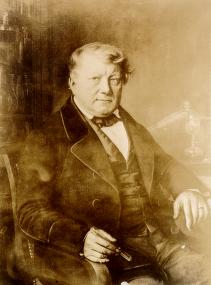
Back Osoon AF Ozono AN ओजोन परत ANP أوزون Arabic অজ’ন AS Ozonu AST Ozon AZ ازون (مولکول) AZB Озон BA Азон BE

| |||
| |||
| Names | |||
|---|---|---|---|
| IUPAC name
Trioxygen
| |||
| Other names
2λ4-trioxidiene; catena-trioxygen
| |||
| Identifiers | |||
3D model (JSmol)
|
|||
| ChEBI | |||
| ChemSpider | |||
| ECHA InfoCard | 100.030.051 | ||
| EC Number |
| ||
| Gmelin Reference | 1101 | ||
| MeSH | Ozone | ||
PubChem CID
|
|||
| RTECS number |
| ||
| UNII | |||
CompTox Dashboard (EPA)
|
|||
| |||
| Properties | |||
| O3 | |||
| Molar mass | 48.00 g·mol−1 | ||
| Appearance | Colourless to pale blue gas< | ||
| Odor | Pungent | ||
| Density | 2.144 mg cm−3 (at 0 °C) | ||
| Melting point | −192.2 °C; −313.9 °F; 81.0 K | ||
| Boiling point | −112 °C; −170 °F; 161 K | ||
| 1.05 g L−1 (at 0 °C) | |||
| Solubility in other solvents | Very soluble in CCl4, sulfuric acid | ||
| Vapor pressure | 55.7 atm[1] (−12.15 °C or 10.13 °F or 261.00 K)[a] | ||
| +6.7·10−6 cm3/mol | |||
Refractive index (nD)
|
1.2226 (liquid), 1.00052 (gas, STP, 546 nm — note high dispersion)[2] | ||
| Structure | |||
| C2v | |||
| Digonal | |||
| Dihedral | |||
| Hybridisation | sp2 for O1 | ||
| 0.53 D | |||
| Thermochemistry | |||
| Std enthalpy of formation ΔfH |
142.67 kJ mol−1 | ||
| Standard molar entropy S |
238.92 J K−1 mol−1 | ||
| Hazards | |||
| NFPA 704 |
| ||
| U.S. Permissible exposure limit (PEL) |
TWA 0.1 ppm (0.2 mg/m3) | ||
| Related compounds | |||
| Related compounds | {{{value}}} | ||
Except where otherwise noted, data are given for materials in their standard state (at 25 °C [77 °F], 100 kPa). | |||
| Infobox references | |||

Ozone, or trioxygen, is a chemical with the symbol O3. This means one molecule of ozone is made of three oxygen atoms. Ozone is rarely called trioxygen, even though this is its IUPAC systematic name.[3] Ozone is formed from oxygen gas (O2) by the action of ultraviolet light and also atmospheric electrical discharges. It is present in low concentrations throughout the Earth's atmosphere. In total, ozone makes up only 0.6 ppm (parts per million) of the atmosphere by volume.
Ozone is important to life on planet Earth. There is a portion of the stratosphere with a high concentration of ozone, called the ozone layer. The ozone layer is 10 to 50 kilometers above the ground. It filters out damaging ultraviolet radiation from the Sun,[4] like a kind of sun screen. Without this ozone layer things would not have been able to live on the surface of our planet. The ozone layer also absorbs a lot of heat from the sun's rays.
However, ozone is toxic to animals and plants above concentrations of about 0.1 ppm. In humans, it can cause nasal and throat irritation, and nausea.[5] Extended exposure can cause lung oedema.[5] 0.100 ppm is the maximum allowable limit for industrial, public, or occupied spaces in England, Japan, France, the Netherlands and Germany.[5]
The ozone near the ground forms because of pollution. It is formed by a chemical reaction between volatile organic compounds and nitrogen oxides. These molecules are common pollutants in cities. Ozone at ground level creates smog.[6]
- ↑ Gas Encyclopedia; Ozone
- ↑ Cuthbertson, Clive; Cuthbertson, Maude (1914). "On the Refraction and Dispersion of the Halogens, Halogen Acids, Ozone, Steam Oxides of Nitrogen, and Ammonia". Philosophical Transactions of the Royal Society A. 213 (497–508): 1–26. Bibcode:1914RSPTA.213....1C. doi:10.1098/rsta.1914.0001. Retrieved 4 February 2016.
- ↑ Nomenclature of Inorganic Chemistry IUPAC Recommendations 2005 (PDF). RSC Publishing. 2005. IR-3.4.3. ISBN 0-85404-438-8. Archived from the original (PDF) on 2019-12-19. Retrieved 16 June 2020.
7. Formula ... O3 ... Systematic name ... trinitrogen ... Acceptable alternative name ... ozone
- ↑ "Stratospheric ozone". Ministry for the Environment (New Zealand). 2013-07-18. Archived from the original on 2015-01-14. Retrieved 2014-03-03.
- ↑ 5.0 5.1 5.2 "Ozone Safety Limits". Understanding Ozone. Archived from the original on 2013-11-11. Retrieved 2013-11-21.
- ↑ "Ground-level Ozone Basics". www.epa.gov. 14 June 2022. Retrieved 10 February 2023.
<ref group=lower-alpha> tags or {{efn}} templates on this page, but the references will not show without a {{reflist|group=lower-alpha}} template or {{notelist}} template (see the help page).


